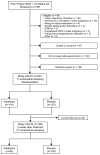Impact of interconception antibiotics on the endometrial microbial flora
- PMID: 17346530
- PMCID: PMC1857329
- DOI: 10.1016/j.ajog.2007.01.014
Impact of interconception antibiotics on the endometrial microbial flora
Abstract
Objective: The purpose of this study was to evaluate the impact of an interconception antibiotic regimen on endometrial microbial flora and histologic type.
Study design: This was a secondary analysis of a double-blind randomized placebo-controlled trial of prophylactic metronidazole plus azithromycin that was given to 241 women (antibiotics, 118 women; placebo, 123 women) with a previous preterm delivery to prevent recurrent preterm delivery. Endometrial cultures and histologic types were obtained at randomization and 2 weeks after treatment. The prevalence of either the new acquisition or the resolution of individual microbes, categories of microbes, and plasma cell endometritis were compared by chi-square or Fishers' exact tests.
Results: Overall, antibiotics were associated with lower acquisition and higher resolution of microbes. Of women without Gardnerella at baseline, 14% of the women who received antibiotics vs 34% of the women who received placebo had positive endometrial culture for the organism after treatment (P < .05); of those women with G. vaginalis at baseline, 57% of the women who received antibiotics vs 33% of the women who received placebo (P < .05) had a negative follow-up culture. Other gram-negative rods, especially aerobes in general, manifested similar patterns. The impact on anaerobes and plasma cell endometritis was not definitive, but there was a trend toward the increased resolution of the former (77% vs 55%) and reduced acquisition of the latter (28% vs 50%).
Conclusion: The antibiotic regimen prevented the acquisition and promoted the resolution, but not the eradication, of gram-negative rods such as G. vaginalis and the aerobic subcategory.
Figures
References
-
- Espinoza J, Erez O, Romero R. Preconceptional antibiotic treatment to prevent preterm birth in women with a previous preterm delivery. Am J Obstet Gynecol. 2006;194(3):630–7. - PubMed
-
- Andrews WW, Goldenberg RL, Hauth JC, Cliver SP, Conner M, Goepfert AR. Endometrial microbial colonization and plasma cell endometritis after spontaneous or indicated preterm versus term delivery. Am J Obstet Gynecol. 2005;193(3 Pt 1):739–45. - PubMed
-
- Goldenberg RL, Hauth JC, Andrews WW. Intrauterine infection and preterm delivery. N Engl J Med. 2000;342:1500–1507. - PubMed
-
- Andrews WW, Hauth JC, Goldenberg RL. Infection and preterm birth. Am J Perinatol. 2000;17:357–365. - PubMed
-
- Hillier SL, Martius J, Krohn M, Kiviat N, Holmes KK, Eschenbach DA. A case-control study of chorioamnionic infection and histologic chorioamnionitis in prematurity. N Engl J Med. 1988;319:972–978. - PubMed
Publication types
MeSH terms
Substances
Grants and funding
LinkOut - more resources
Full Text Sources
Medical


